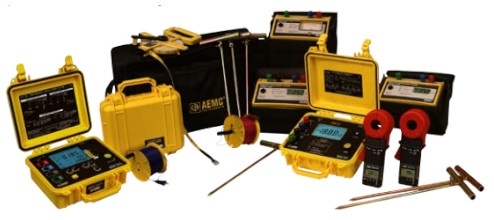Choosing the Right Ground Resistance Tester
Choosing the Right Ground Resistance Tester
May 14th, 2021:
There are a wide variety of ground resistance testers available on the market today. These vary in design, features, and complexity, and include small handheld models as well as larger field instruments that are often packaged as part of a complete kit. These products also range in price, from a few hundred up to several thousand dollars. In this article, we discuss several critical questions to consider when selecting a ground resistance tester. Our goal is to help guide you in choosing the instrument best suited to your specific application and requirements.

Do you need to regularly test sites for soil resistivity?
The first, and probably most important, question is whether your current or future needs require soil resistivity testing, because it will determine the type of ground resistance tester you will need. For example, if your work involves the design and/or installation of new grounding systems, soil resistivity testing is a necessity. An instrument designed for 4-pole testing (also referred to as 4-point testing) is required for this application. A basic low-cost 4-pole tester provides measurement results in ohms. You can then use this reading to manually calculate soil resistivity, which is usually expressed in ohm/centimeters or ohm/meters.
More sophisticated instruments include built-in formulas for calculating soil resistivity using the Wenner or the Schlumberger method. If you regularly need to perform 4-pole testing, consider purchasing an instrument that automatically calculates soil resistivity. This will save time and eliminate potential math errors.
What type(s) of ground systems will you test?
the obvious follow-up question involves the types of grounding systems you will test. Will this include small systems such as residential, or larger and more complex systems such as commercial, industrial, telecommunication, or electric utilities? To illustrate the importance of this question, let’s consider a typical small site with a grounding system consisting of a copper rod or two, driven into the ground and connected to the service entrance.

In the above illustration, if the house has not yet been connected to the power line, a basic 3-pole ground resistance tester (or a 4-pole instrument configured for 3-pole testing) will suffice for measuring the resistance of the house ground rod. If the house has been connected to the power line, a clamp-on ground resistance tester can measure the house ground rod resistance. If you choose a 3- or 4-pole instrument for this, one point to bear in mind is the distances required for auxiliary rod placement. For example, performing a Fall-of-Potential test on a single electrode rod driven 8 feet deep requires at least 80 to 100 foot test leads. If more ground rods are used, the distance requirement increases. Ground resistance test kits are available that include the measurement instrument, the auxiliary electrodes, and leads. Typical lead lengths provided in these kits are 150, 300, and 500 feet. We suggest selecting a ground resistance test kit with leads at least one size longer than your immediate need. So if 150 feet is required, a kit that includes 300 foot leads will provide a good margin of error. For larger sites with multiple rods or ground grids, consider kits that provide 500 foot leads.
Does the test site have high soil resistivity and/or requires long test leads?
Another question is whether the soil resistivity is high in the area that you will be testing, or whether the distance required for the auxiliary rods to perform Fall-of-Potential testing is unusually long. If the answer to either or both of these questions is yes, and you intend to perform Fall-of-Potential and/or soil resistivity tests, you must consider the instrument’s injection current and test voltage. Typical injection currents range from a few milliamps up to several hundred mA. High soil resistivity usually produces high contact resistance for the auxiliary electrodes. This can be of concern when using lower-cost instruments that typically provide 10mA test current; so in this circumstance we recommend an instrument capable of delivering higher test current.
Before we leave the topic of auxiliary electrodes, note that clamp-on instruments do not require any auxiliary rods or leads. Another advantage is that you do not need to take the grounding system out of service to perform the test.
Is electromagnetic interference (EMI) present?
Another subject to consider is whether electromagnetic interference, or EMI, is present at the test site. EMI can result in unstable or inaccurate readings, particularly at lower test frequencies. The most common test frequency is 128Hz. Instruments that feature automatic test frequency selection can find the “cleanest” available frequency, which provides an advantage in high-EMI environments. Clamp-on instruments can also be effective in such locations, since they typically test at higher frequencies. Newer AEMC clamp-on models also offer test frequency selection.
Note that in some high-inductive environments lower test frequencies can produce more reliable results.
How will you use the measurement data?
The choice of instrument can also depend on how you intend to use the data you obtain. For example, if you plan to save, analyze, and distribute your test results, data storage and report generation become important considerations. Newer and more advanced instruments, both 3- and 4-pole testers and clamp-on models, can store test results in internal memory. This data can then be downloaded and analyzed using software running on a computer, or via mobile apps for smartphones and tablets. This can be a very powerful tool for contractors conducting tests for clients. An added advantage for a mobile app is the ability to immediately send test results as an e-mail or text message.

AEMC DataView® Ground Tester Resistance vs Frequency report (above, left) and AEMC Model 6417 Android™ app (above, right)
Do you need to test the bonding of grounding system components?
Finally, if you’re planning to test complex grounding system consisting of many components including a ground mat or grid, you will need to test the continuity of bonding between the various elements. This test is most often conducted using DC voltage and current. Several ground resistance testers provide this capability, with test currents up to a few hundred milliamps. In addition, a more complete test can be performed with a micro-ohmmeter. The advantage in using this instrument is its ability to test at high test currents up to 200A. This can expose problem areas not always revealed when testing with milliamp-range currents.
In Conclusion
Let’s take a moment to review:
- When deciding which ground resistance tester is right for you, consider whether or not you need an instrument that can measure soil resistivity.
- If so, think about what types of ground systems you are likely to test.
- Take into consideration the environmental factors at your potential test sites, such as high soil resistivity or EMI.
- Bear in mind how you plan to use the measurement data.
- If you need to measure complex grounding systems, consider an instrument that can perform continuity checking on the bonding between components.
Note: Information taken from an application note courtesy of AEMC Instruments (via the AEMC Instruments website). Ram Meter Inc. sells and stocks an assortment of AEMC Instruments Ground Resistance Testers which can be found on our website at www.rammeter.com/test-equipment-tools/ground-resistance-testers You can also check out our full selection of other Ground Resistance Testers.
